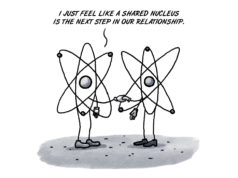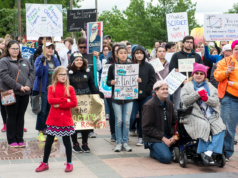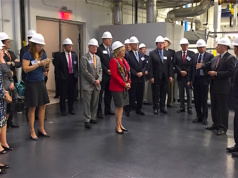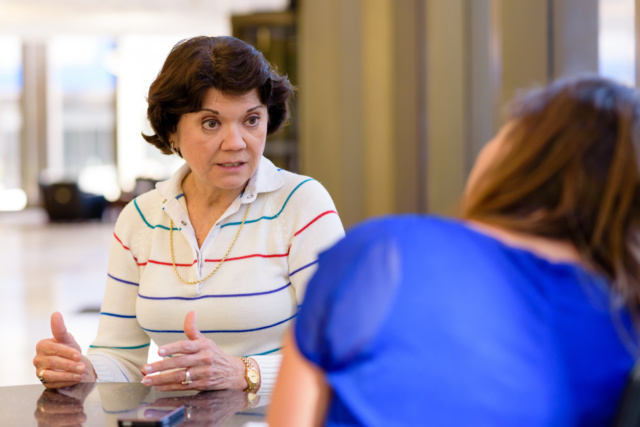
From 2008 to 2013, America was hooked on the AMC series Breaking Bad, a dark show about a chemistry teacher diagnosed with lung cancer who begins producing and selling crystallized methamphetamine to fund his treatment.
Watching the show served as more than just a guilty pleasure for the general public. It also boosted interest in the hard science of chemistry. Viewers were hooked when the show explained how hydrofluoric acid eats away bone but not plastic. They loved seeing Walter White create an explosion with mercury fulminate in the office of a drug kingpin. They were captivated when he created thermite from Etch-A-Sketch fillings to burn through a metal door.
Breaking Bad made chemistry cool for everyone, and it was partially thanks to the detailed eye of University of Oklahoma chemistry professor Donna Nelson, who served as the show’s science adviser.
“I watched the first five episodes and realized that the show doesn’t glorify meth or drug culture. Walter had a horrible life. He got punished so much,” Nelson said. “I couldn’t imagine anyone looking at Walter White and saying, ‘I want to be like that,’ but I saw a wonderful opportunity to bring science to Hollywood.”
Much like the “CSI effect,” which is how the exaggerated portrayal of forensic science on crime shows influences public perception, Nelson believes Breaking Bad may have done more for attracting young people to science fields than years of public relations.
While elementary and high school programs have encouraged participation in science, technology, engineering and math (STEM) fields with great success, Nelson believes pop culture’s glorification of hard sciences is needed to attract even more students.
“We need more TV shows that make science sexy,” she said.
‘I want to grow up to be a molecular biologist!’
When Nelson earned her PhD in chemistry at the University of Texas Austin, she was the first female to do her post-doctorate work with Herbert Charles Brown, a Nobel Prize joint winner in chemistry at Purdue University.
Nelson was also the first woman to be on the tenure track as a professor of chemistry at OU. In the late 1990s, she was one of only 10 women nationally doing research in organic chemistry.
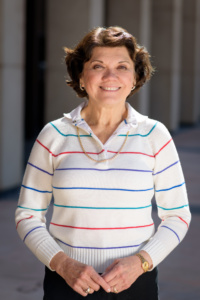
“There just weren’t that many women in science at that time,” said Nelson, who is past president of the American Chemistry Society, the world’s largest scientific society. “A lot of women didn’t work, and if they did choose to be a scientist, they became science teachers at high schools. They didn’t earn PhDs or postdoctorates. There were very few women mentors.”
For most of her career, Nelson has tried to reverse that trend. She wants more women and minorities to become top-level scientists and wants science to be as attractive to students as fields like criminal justice or law.
In Oklahoma and the nation, scholars and policy makers exclaimed for years that women are historically underrepresented in STEM fields. Nelson said that trend is reversing.
“In general, we are seeing more students in these fields,” she said. “The other thing that I’m happy about is that students are much more prepared when they enter college. They come in smarter. It’s all very encouraging. The number of women, Native Americans, Hispanics and African Americans enrolled in sciences at the undergraduate level has all increased.”
The next step, however, is to make science careers sexy and exciting. Instead of children declaring that they want to be a doctor or a fireman, Nelson wants them to get excited to say, “I want to grow up to be a molecular biologist or mechanical engineer!”
She said the best way to make that happen is to bring science to Hollywood and make scientists the new heroes in television shows.
‘Anything a man can do, a woman can fix’
According to a 2011 U.S. Department of Commerce study, A Gender Gap to Innovation, women fill close to half of all jobs in the U.S. economy but hold less than 25 percent of STEM jobs.
Women also have a disproportionately low share of STEM undergraduate degrees, particularly in engineering. In addition, women with a STEM degree are less likely than their male counterparts to work in a STEM occupation; they are more likely to work in education or health care.
Minority women comprise even lower percentages.
According to the National Science Foundation’s study Women, Minorities, and People with Disabilities in Science and Engineering, 2015, less than 14.2 percent of bachelor’s degrees in all sciences were awarded to minority women in 2012; in some fields, only 3 percent.
Nelson herself pioneered research showing how that disparity continued into faculty demographics at major learning institutions. In 2000, she published the first Nelson Diversity Survey, which catalogued the number of faculty at the professor, associate professor and assistant professor levels in American chemistry programs by gender and race.
“We found there were zero black assistant professors in the top 50 programs, which means none had been hired in the last seven years,” she said. “There were no Native American assistant professors either. The number of women was low as well.”
She has since headed up three additional Nelson Diversity Surveys for the top 100 programs in 15 different science fields.
“We’ve seen change over the years. For women, we’ve seen the number increase in all fields,” she said. “I think women have reached critical mass. Women are no longer silent, and they are vocal about what they want. I think we will eventually reach a parity.”
The increase in women in science is owed in part to aggressive STEM programs on statewide and national levels. For instance, the Oklahoma State Department of Education STEM Team was formed to provide leadership, support and resources to create effective STEM learning environments. Likewise, the Oklahoma STEM Foundation exists to provide mentoring and hands-on learning programs for children and parents in STEM fields. The GE Foundation, a philanthropic organization of GE, recently made a donation of $400,000 to the Oklahoma Center for the Advancement of Science and Technology (OCAST). That money supported the launch of STEM Empowers OK, a statewide initiative to engage and inspire greater interest among high school students in science, technology, engineering and mathematics.
Brandi VanAlphen of Oklahoma City is among the growing ranks of women in science. A chemist who worked in research at OU, VanAlphen is now a science teacher at an Oklahoma City high school. She said the biggest challenge she sees is keeping women in the field.
“Pop culture needs to romanticize staying in the field. We are getting into the field, but it’s still a man’s world,” VanAlphen said. “It’s easier for male counterparts to succeed in science, especially if women want to start a family. But I think it will change. Anything a man can do, a woman can fix. We just need to fix enough things to make that happen.”
‘Television shows influence students’
Breaking Bad earned respect for getting the science right (mostly) thanks in big part to Nelson. She volunteered her expertise as a science adviser to series creator Vince Gilligan after reading an interview in which he asked for assistance.
Although Nelson pointed out that Walt’s signature “blue meth” on the show isn’t scientifically correct, the interest in science was.
“We need shows where scientists are the heroes,” Nelson said. “These TV shows come into our homes every week, and we can influence culture that way to make science more appealing to the masses.”
Lawrence Richardson, career development specialist for the University of Central Oklahoma Career Services, agrees.
“I really do feel mass media and television shows influence students and emerging adults when it comes to career choices,” he said. “When I work with students, I ask what type of media or shows they enjoy. If they like the character of Gabby on ‘CSI,’ it’s because she’s the nerd and does all the neat lab tech-y work. Science may be something they could be interested in.”
Richardson said popular media impact career choices and decision making. On the opposite scope, controlling images — how dominant groups affect non-dominant groups like women and minorities — typically portray women in careers that are more nurturing, leading women to think they are not meant to be engineers or scientists.
“If we had more representation of STEM fields in media, what impact would that have for women and minorities?” Richardson said. “If people don’t see those images of scientists related to images of success, then they feel it’s not worth it. If we can start to portray science in a positive light in popular media, then we can start to achieve those goals of attracting more women and minorities to those fields.”










